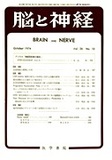Japanese
English
- 有料閲覧
- Abstract 文献概要
- 1ページ目 Look Inside
CDP-cholineが,頭部外傷による意識障害を始めとする中枢神経疾患,例えば睡眠薬中毒,麻酔覚醒不全,脳卒中後遺症,パーキンソン症候群などに有効であることは,従来の多くの報告にみられる通りである9〜12)。ところでCDP-cholineは,損傷脳においては脳に比較的よくとりこまれるが,健康な脳においては血液脳関門を通りにくいとされる2,17)。しかし髄腔内に投与すると逆に排出されにくく6),米川(1970)によれば,2〜6時間以上一定の値が持続するという20)。オートラジオグラフィーを用いた実験でも,静注内投与に比べ髄腔内投与の方がCDP-cholineは大量にしかも長時間中枢神経内にとどまることが示されている14)。一般に,薬物を髄腔内投与すると,血液内投与に比べ同じ効果をあらわすのに1/5〜1/25(平均1/15)でよいことが知られ,特に髄腔内投与の際,血管内投与でみられない特異的な効果が出現することもある7)。
以上のような観点から,CDP-cholineの髄腔内投与で血液内投与に比べはるかにすぐれた臨床効果,あるいは後者にみられない効果が得られる可能性が推定される。事実,そのような臨床報告もいくつかなされている1,4,8,14〜16,21)。そこでCDP-cholineについて静脈内投与(intravenous administration,以下IV投与と略す)と髄腔内投与(intrathecal administration,以下IT投与と略す)の効果を,実験的に厳密に比較検討することは有意義であろう。そのためにはできるだけ客観的で明解な指標を用いて検討したい。その目的には脳波の回復を指標とするのが適当と判断した。その理由は次の通りである。①CDP-cholineが脳波に著明な賦活効果を有していることが,多くの実験的・臨床的研究に示されること3,5,10,11,18),②動物実験の場合,意識の状態や反応などよりも客観的に効果が分析できること,③一定の障害モデルを作りやすいこと,などによる。
CDP-choline (cytidine diphosphate choline) is effective for the treatment of intracranial organic lesions, such as head injury, Parkinsonism, cere-brovascular disease, etc., CDP-choline can be admini-strated via intrathecal route as well as intravenous or intramuscular one.
The availability of intrathecal CDP-choline was tested on 26 paralized, artificially respirated cats, by observing the recovery of disturbed EEG, which was produced by pressure by mean of ballooning on the midbrain for ten minutes enough to flatten the EEG (Fig. 1). The EEG grade that was used in this experiment was shown in Figure 2.
The EEG of control group recovered very slowly and insufficiently as shown in Figure 3, whereas the EEG of cats with intrathecally administrated CDP-choline exhibited remarkable and sufficient improvement as well as those with intravenous administration (Figs. 4 and 5). The former re-covery was faster than the latter one. The effective-ness of CDP-choline was enhanced to maximum by combinated administration of intrathecal and in-travenous CDP-choline as shown in Figures 6 and 7, the mechanism of which was diagramatized in Figure 8.

Copyright © 1974, Igaku-Shoin Ltd. All rights reserved.


